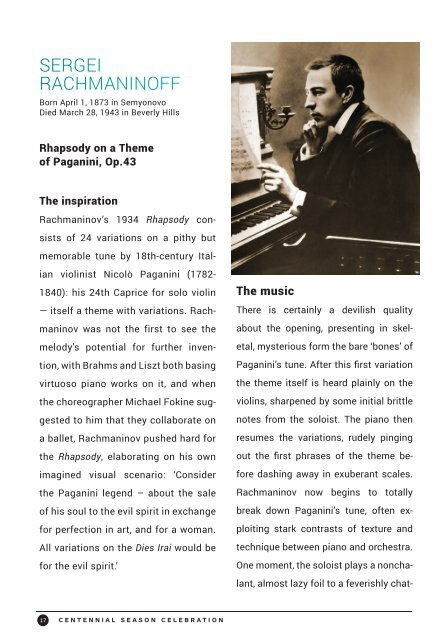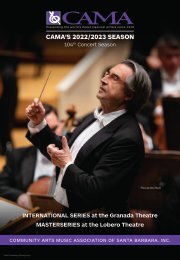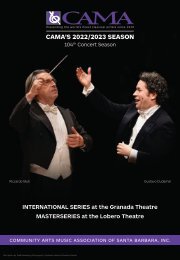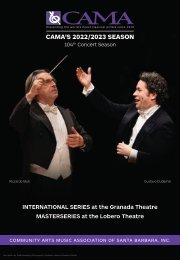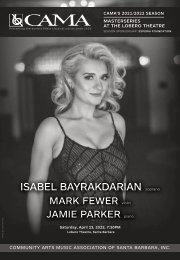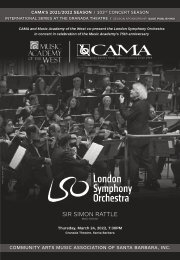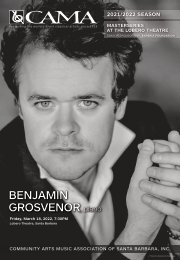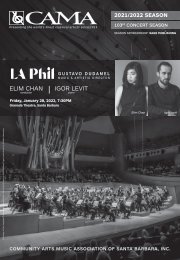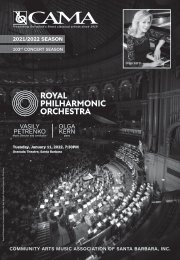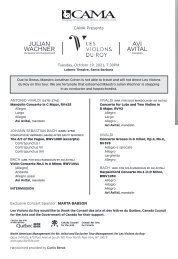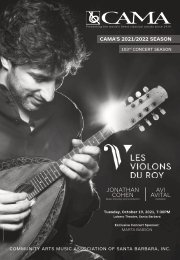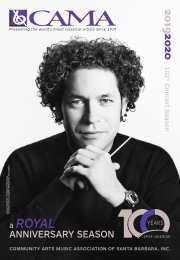Friday, April 5, 2019—CAMA Presents Royal Scottish National Orchestra—International Series at The Granada Theatre—Santa Barbara, CA—8:00 PM
FRIDAY, APRIL 5, 2019, 8:00 PM CAMA Presents Royal Scottish National Orchestra Thomas Søndergård, Music Director Olga Kern, piano Since its founding in 1891, the Royal Scottish National Orchestra has played an integral role in the musical life of its namesake country, including performing at the opening ceremony of the Scottish Parliament building in 2004. Known originally as the Scottish Orchestra, the ensemble was awarded Royal Patronage in 1977. Today the orchestra is led by the brilliant Danish conductor Thomas Søndergård serving his first season as music director. The RSNO program will feature symphonies by Sibelius and Prokofiev and also will celebrate Rachmaninoff’s 100th Anniversary in the US with a performance of his Rhapsody on a Theme of Paganini with Russian-American piano soloist Olga Kern, the first woman to receive the Gold Medal at the prestigious Van Cliburn Piano Competition, back in 2001. PROGRAM: Jean Sibelius: Symphony No.7 in C major, Op.105 Sergei Rachmaninoff: Rhapsody on a Theme of Paganini, Op.43 Sergei Prokofiev: Symphony No.5 in B-flat major, Op.100 PRE-CONCERT LECTURE BY ROBERT KOENIG, Professor and Vice Chair, Department of Music, UC Santa Barbara Lecture will begin at 7:00 PM; doors to The Granada Theatre will open for the lecture at 6:45 PM. Lecture seating is limited to the first 100 patrons. First come, first served. #####
FRIDAY, APRIL 5, 2019, 8:00 PM
CAMA Presents
Royal Scottish National Orchestra
Thomas Søndergård, Music Director
Olga Kern, piano
Since its founding in 1891, the Royal Scottish National Orchestra has played an integral role in the musical life of its namesake country, including performing at the opening ceremony of the Scottish Parliament building in 2004. Known originally as the Scottish Orchestra, the ensemble was awarded Royal Patronage in 1977. Today the orchestra is led by the brilliant Danish conductor Thomas Søndergård serving his first season as music director. The RSNO program will feature symphonies by Sibelius and Prokofiev and also will celebrate Rachmaninoff’s 100th Anniversary in the US with a performance of his Rhapsody on a Theme of Paganini with Russian-American piano soloist Olga Kern, the first woman to receive the Gold Medal at the prestigious Van Cliburn Piano Competition, back in 2001.
PROGRAM:
Jean Sibelius: Symphony No.7 in C major, Op.105
Sergei Rachmaninoff: Rhapsody on a Theme of Paganini, Op.43
Sergei Prokofiev: Symphony No.5 in B-flat major, Op.100
PRE-CONCERT LECTURE BY ROBERT KOENIG, Professor and Vice Chair, Department of Music, UC Santa Barbara
Lecture will begin at 7:00 PM; doors to The Granada Theatre will open for the lecture at 6:45 PM.
Lecture seating is limited to the first 100 patrons. First come, first served.
#####
Create successful ePaper yourself
Turn your PDF publications into a flip-book with our unique Google optimized e-Paper software.
SERGEI<br />
RACHMANINOFF<br />
Born <strong>April</strong> 1, 1873 in Semyonovo<br />
Died March 28, 1943 in Beverly Hills<br />
Rhapsody on a <strong>The</strong>me<br />
of Paganini, Op.43<br />
<strong>The</strong> inspir<strong>at</strong>ion<br />
Rachmaninov’s 1934 Rhapsody consists<br />
of 24 vari<strong>at</strong>ions on a pithy but<br />
memorable tune by 18th-century Italian<br />
violinist Nicolò Paganini (1782-<br />
1840): his 24th Caprice for solo violin<br />
— itself a theme with vari<strong>at</strong>ions. Rachmaninov<br />
was not the first to see the<br />
melody's potential for further invention,<br />
with Brahms and Liszt both basing<br />
virtuoso piano works on it, and when<br />
the choreographer Michael Fokine suggested<br />
to him th<strong>at</strong> they collabor<strong>at</strong>e on<br />
a ballet, Rachmaninov pushed hard for<br />
the Rhapsody, elabor<strong>at</strong>ing on his own<br />
imagined visual scenario: ‘Consider<br />
the Paganini legend – about the sale<br />
of his soul to the evil spirit in exchange<br />
for perfection in art, and for a woman.<br />
All vari<strong>at</strong>ions on the Dies Irai would be<br />
for the evil spirit.’<br />
<strong>The</strong> music<br />
<strong>The</strong>re is certainly a devilish quality<br />
about the opening, presenting in skeletal,<br />
mysterious form the bare ‘bones’ of<br />
Paganini’s tune. After this first vari<strong>at</strong>ion<br />
the theme itself is heard plainly on the<br />
violins, sharpened by some initial brittle<br />
notes from the soloist. <strong>The</strong> piano then<br />
resumes the vari<strong>at</strong>ions, rudely pinging<br />
out the first phrases of the theme before<br />
dashing away in exuberant scales.<br />
Rachmaninov now begins to totally<br />
break down Paganini’s tune, often exploiting<br />
stark contrasts of texture and<br />
technique between piano and orchestra.<br />
One moment, the soloist plays a nonchalant,<br />
almost lazy foil to a feverishly ch<strong>at</strong>-<br />
17 CENTENNIAL SEASON CELEBRATION


